The Aquatic Graveyards
Earth in Upheaval Revisited – Part 7
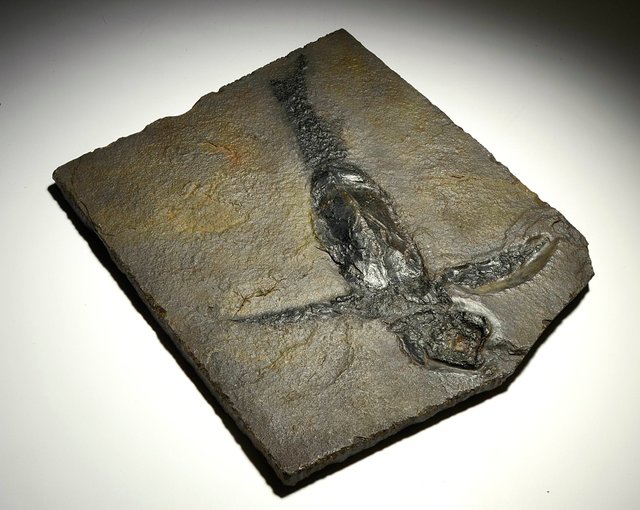
Chapter 2 of Immanuel Velikovsky’s Earth in Upheaval, bears the title Revolution and has four sections. In the last of these, The Aquatic Graveyards, Velikovsky examines the Old Red Sandstone for evidence of catastrophism, relying heavily on a single source, Hugh Miller’s monograph of 1841.
The Old Red Sandstone (ORS) is a system of sedimentary rocks found in several countries bordering the North Atlantic : Canada, Greenland, Norway, Great Britain and Ireland. These sediments were laid down, according to current estimates, between the late Silurian and early Carboniferous—approximately 420 to 360 million years ago (Mya). The name is misleading: the Old Red Sandstone also includes conglomerates, mudstones, siltstones and limestones, and the colour of the ORS varies from grey and green to red and purple.
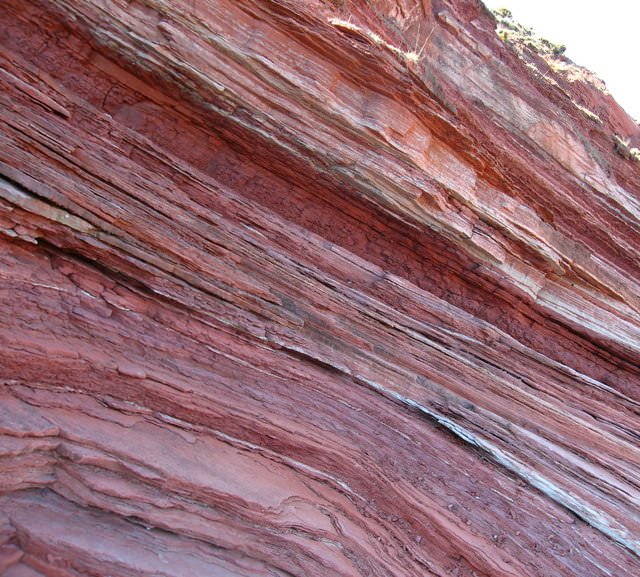
Associated with the Old Red Sandstone is a characteristic assemblage of fossils comprising plants, arthropods and early fishes. The Devonian (420-360 Mya), during which most of the ORS was laid down, is sometimes referred to as the Age of Fishes.
In the 19th century, shortly after the discovery of the Old Red Sandstone, geologists keenly debated the significance of the system:
Was it merely a local production, and not sufficiently extensive to be ranked as a geological system in its own right?
Were its sediments of oceanic or continental origin?
Today, this debate is considered closed: the ORS is now known to be of considerable extent, and there is a scholarly consensus that its sediments are not of marine origin, but were deposited primarily in lakes and river beds across the former continent of Laurussia (also known as Euramerica):
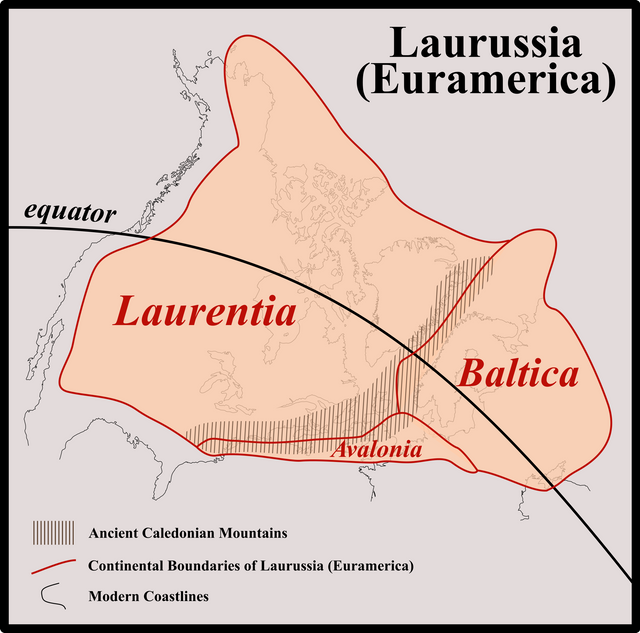
Shortly after the Old Red Sandstone was first discovered and identified, it was found to contain the fossilized remains of primitive plants and animals. Further study showed that it was in fact an extremely rich source of fossils, particularly those of primitive fishes. One of the pioneers in this field of research was Hugh Miller, whose monograph on the system was first published in Edinburgh in 1841.
Hugh Miller
Hugh Miller was a Scottish geologist, who made the Old Red Sandstone of his native land the focal point of his investigations. Working in quarries as a stonemason fostered an early interest in geology, though he never received any formal training in the field. Everything he knew on the subject he learnt through his reading and his fieldwork, both of which were extensive. He also wrote several books of scientific interest, which have stood the test of time. Early in his career, his work attracted the attention and admiration of professionals in the field, most notably Roderick Murchison and Louis Agassiz. It was Murchison who encouraged him to preserve the fruits of his research in a monograph on the Old Red Sandstone.
Throughout his life, Miller suffered from mental illness. He was periodically tormented with severe headaches and was subject to attacks of “nervous melancholy” and “fits of partial somnambulism” (Mackenzie 98). In 1856, at the age of 52, he took his own life, fearing that he might harm his family during one of his psychotic episodes.

Like many of the catastrophists Velikovsky cites in Earth in Upheaval, Miller was an evangelical Christian, who was faced with the challenge of bringing his scientific opinions into harmony with deeply held Christian beliefs. He spent the last sixteen years of his life as editor of Witness, a religious journal he founded and to which he was the principal contributor. In many respects, his work as a geologist was of secondary interest to him.
Miller occupied a sort of no man’s land between science and religion. He defended geology against the Fundamentalists as much as he defended Christianity against the Freethinkers. He accepted the deep time of his fellow geologists, who measured the age of the Earth in millions rather than thousands of years, but he also believed that the Bible was a divinely inspired text. In his final work, a series of lectures entitled The Testimony of the Rocks, he sought to reconcile these two apparently contradictory positions. In the preface to this work, he described how his opinions had evolved over time as a result of his fieldwork, which induced him to abandon gap-creationism in favour of day-age creationism:
It will be seen that I adopt, in my Third and Fourth Lectures, that scheme of reconciliation between the Geologic and Mosaic Records which accepts the six days of creation as vastly extended periods; and I have been reminded by a somewhat captious critic that I once held a very different view, and twitted with what he terms inconsistency. I certainly did once believe with Chalmers and with Buckland that the six days were simply natural days of twenty-four hours each,—that they had comprised the entire work of the existing creation,—and that the latest of the geologic ages was separated by a great chaotic gap from our own ... All I found necessary at the time to the work of reconciliation was some scheme that would permit me to assign to the earth a high antiquity, and to regard it as the scene of many succeeding creations. During the last nine years, however ... the conclusion at which I have been compelled to arrive is, that for many long ages ere man was ushered into being, not a few of his humbler contemporaries of the fields and woods enjoyed life in their present haunts, and that for thousands of years anterior to even their appearance, many of the existing molluscs lived in our seas. That day during which the present creation came into being, and in which God, when he had made the beast of the earth after his kind, and the cattle after their kind, at length terminated the work by moulding a creature in His own image, to whom he gave dominion over them all, was not a brief period of a few hours’ duration, but extended over mayhap millenniums of centuries. No blank chaotic gap of death and darkness separated the creation to which man belongs from that of the old extinct elephant, hippopotamus, and hyaena ... and so I have been compelled to hold, that the days of creation were not natural, but prophetic days, and stretched far back into the bygone eternity. (Miller 1857:x-xi)
Miller, however, drew the line at evolution. On the appearance of fishes in the fossil record, he wrote:
Another and superior order of existences had sprung into being at the fiat of the Creator ... (Miller 1865:215)
Evolution—or the Development Hypothesis, as it was then commonly called—he dismissed as not only incompatible with his Christian beliefs but also unattested in the geologic record. In Foot-Prints of the Creator, he summarized his position in these uncompromising words:
No true geologists holds by the development hypothesis; — it has been resigned to sciolists and smatterers; — and there is but one other alternative. They began to be, through the miracle of creation. (Miller 1849:277)
Miller did not live to read Darwin’s Origin of Species.
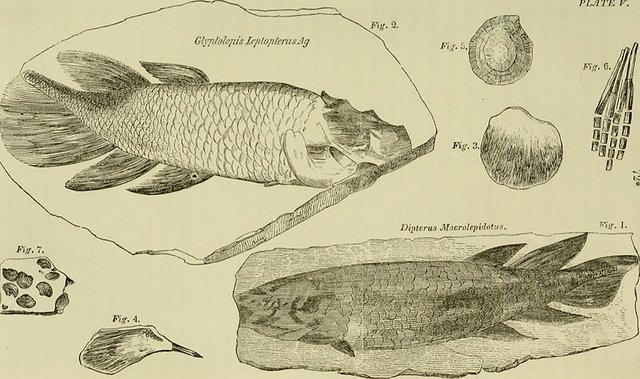
The Old Red Sandstone
Miller’s opus magnum, The Old Red Sandstone, or, New Walks in an Old Field, was first published in Edinburgh in 1841. It has proved so popular with both scholars and the general public that it has gone through fourteen editions since its first appearance and has remained in print to the present day. Velikovsky consulted an enlarged and revised edition of the book, which was published in Boston by Gould & Lincoln in 1865. This is a reprint of the seventh edition of 1857, which was seen through the press by Lydia Miller, the author’s widow, just months after her husband’s tragic death.
It is not surprising that Velikovsky summons Miller to the witness stand. Miller’s description of the extinction of a genus of primitive fish now known as Pterichthyodes is the very stuff of Earth in Upheaval:
The river bull-head, when attacked by an enemy, or immediately as it feels the hook in its jaws, erects its two spines at nearly right angles with the plates of the head, as if to render itself as difficult of being swallowed as possible. The attitude is one of danger and alarm; and it is a curious fact, to which I shall afterwards have occasion to advert, that in this attitude nine-tenths of the Pterichthyes of the Lower Old Red Sandstone are to be found. We read in the stone a singularly-preserved story of the strong instinctive love of life, and of the mingled fear and anger implanted for its preservation, — The champions in distorted postures threat. It presents us, too, with a wonderful record of violent death falling at once, not on a few individuals, but on whole tribes. (Miller 1841:52-53)
Miller was fond of literary allusions, which he scatters throughout his text. The champions in distorted postures threat is a quotation from Alexander Pope’s The Temple of Fame. The next passage that Velikovsky cites begins with an allusion to Shakespeare’s The Tempest.
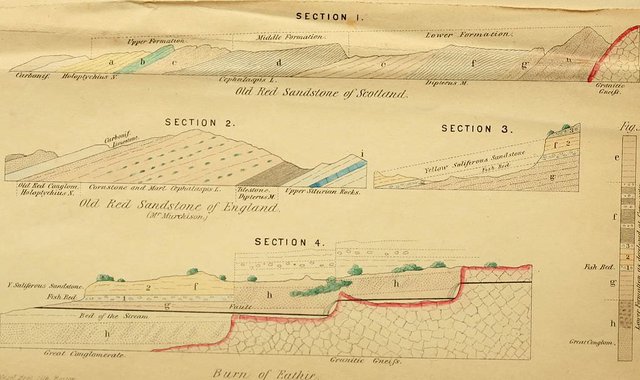
Miller did not hazard a guess as to the nature of the catastrophe that involved in sudden destruction the fish of an area at least a hundred miles from boundary to boundary, perhaps much more (Miller 1841:232). It is significant, however, that Velikovsky blatantly suppresses Miller’s repeated conviction that, whatever the nature of the catastrophe, it was not sufficiently violent to disturb the sea in which the fish died:
There are proofs, that whatever may have been the cause of the catastrophe, it must have taken place in a sea unusually still ... Destruction must have come in the calm, and it must have been of a kind by which the calm was nothing disturbed. In what could it have originated? By what quiet but potent agency of destruction were the innumerable existences of an area perhaps ten thousand square miles in extent annihilated at once, and yet the medium in which they had lived left undisturbed by its operations (Miller 1841:232-233)
Compare this with Velikovsky:
What agency of destruction could have accounted for “innumerable existences of an area perhaps ten thousand square miles in extent [being] annihilated at once”? (Velikovsky 18)
A quiet catastrophe does not suit Velikovsky: hence the surgical editing of Miller’s text. Has Velikovsky deliberately misrepresented Miller?
The following paragraph is not enclosed within quotation marks, but Velikovsky has lifted it from Miller’s text and inserted it into his own with only the slightest emendation:
The ravages of no disease, however virulent, could explain some of the phenomena of this arena of death. Rarely does disease fall equally on many different genera at once, and never does it strike with instantaneous suddenness; yet in the ruins of this platform from ten to twelve distinct genera and many species were involved; and so suddenly did the agency perform its work that its victims were fixed in their first attitude of surprise and terror. (Velikovsky 18)
But the ravages of no such disease, however extensive, could well account for some of the phenomena of this platform of death. It is rarely that disease falls equally on many different tribes at once, and never does it fall with instantaneous suddenness; whereas in the ruin of this platform from ten to twelve distinct genera seem to have been equally involved; and so suddenly did it perform its work, that its victims were fixed in their first attitude of terror and surprise. (Miller 1865:223-224)
Other Sources
Miller confined himself to the study of the Old Red Sandstone of his native Scotland. But the fossilized remains of extinct fishes have also been found in other parts of the globe. In the final section of The Aquatic Graveyards, Velikovsky briefly calls upon the testimony of three other naturalists : William Buckland, George Macready Price and John Muirhead Macfarlane. The first of these was cited by Velikovsky in the previous section of this chapter, The Caves of England, but perhaps a word or two should be said about Price and Macfarlane, one of whom we will be hearing from again.
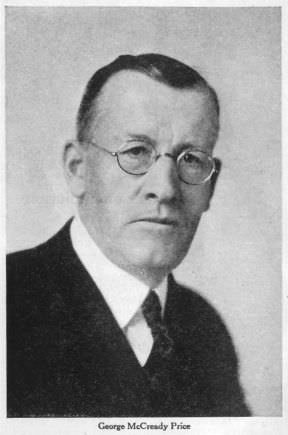
George McCready Price was a Canadian Seventh-Day Adventist and one of the pioneers of creation science. He wrote extensively on geology and evolution and his books have recently come into vogue in the Creationist community. Miller was one of Price’s primary sources—he quotes at length from The Old Red Sandstone—though he did not accept Miller’s Old Earth creationism. Price was a Fundamentalist, who took Genesis 1 literally.

John Muirhead Macfarlane was a Scottish botanist. He was Professor of Botany at the University of Pennsylvania from 1893 until his retirement in 1920. Pennsylvania became the centre of America’s first oil boom after Edwin Drake successfully drilled for oil there in 1859, so it should come as no surprise that Macfarlane took an interest in the petroleum industry. The title of his book Fishes the Source of Petroleum speaks for itself.
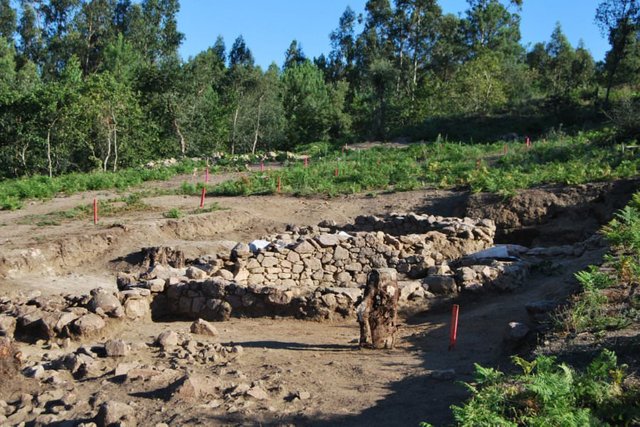
Monte Bolca
William Buckland is Velikovsky’s source for the testimony of Monte Bolca. This site near Verona, in northern Italy, is one of the best and richest sources of fossils in Europe. It boasts such an abundance of well preserved fish fossils that it is known as La Pesciara di Bolca: The Fishbowl of Bolca. What the Old Red Sandstone is to the Devonian fishes, Monte Bolca is to the much more recent Eocene fishes (50-24 Mya).
Buckland’s Geology and Mineralogy was the sixth of The Bridgewater Treatises, a series of papers commissioned from leading scientists by the Earl of Bridgewater in order to explore the apparent intelligent design of our world. Velikovsky is again interested in evidence of sudden and wholesale slaughter, indicative of some great cataclysm. Buckland, however, was satisfied that, while the large-scale fish-kill at Monte Bolca was sudden—Cases of Animals Destroyed Suddenly is the title he gives this section—it was not violent:
The greater number of fossil fishes present no appearance of having perished by mechanical violence; they seem rather to have been destroyed by some noxious qualities imparted to the waters in which they moved; either by sudden change of temperature, or an admixture of carbonic acid, or sulphuretted hydrogen gas, or of bituminous or earthy matter in the form of mud. (Buckland 122-123)
Velikovsky is careful to excise these remarks and only include Buckland’s references to the suddenness of the slaughter and its large scale. Once again, he treads a thin line between citing a source and misrepresenting it:
“The circumstances under which the fossil fishes are found at Monte Bolca seem to indicate that they perished suddenly. ... The skeletons of these fish lie parallel to the laminae of the strata of the calcareous slate; they are always entire, and closely packed on one another. ... All these fishes must have died suddenly ... and have been speedily buried in the calcareous sediment then in the course of deposition. From the fact that certain individuals have even preserved traces of colour upon their skin, we are certain that they were entombed before decomposition of their soft parts had taken place.” (Velikovsky 19)
The following quotation from Buckland is similarly misleading, giving the impression that the victims of another fossilized fish-kill—near the Harz Mountains in Germany—died in agony:
The same author wrote about the fish deposits in the area of the Harz Mountains in Germany: “Another celebrated deposit of fossil fishes is that of the cupriferous slate surrounding the Harz. Many of the fishes of this slate at Mansfeld, Eisleben, etc., have a distorted attitude, which has often been assigned to writhing in the agonies of death. ... As these fossil fishes maintain the attitude of the rigid stage immediately succeeding death, it follows that they were buried before putrefaction had commenced, and apparently in the same bituminous mud, the influx of which had caused their destruction.” (Velikovsky 19)
But Buckland did not claim that the contorted postures preserved the agonizing death throes of the victims:
The true origin of this condition, is the unequal contraction of the muscular fibres, which causes fish and other animals to become stiff, during a short interval between death and the flaccid state preceding decomposition. (Buckland 125)
Velikovsky has again wielded the scalpel to give Buckland’s comments a new slant.
North America
Velikovsky only devotes five lines to the evidence of catastrophic fish kills in North America:
In North America similar strata, “packed full of splendidly preserved fishes,” are found in the black limestone of Ohio and Michigan, in the Green River bed of Arizona, the diatom beds of Lompoc, California, and in many other formations. (Velikovsky 19-20)
The quotation is from George McCready Price’s Evolutionary Geology and New Catastrophism. With a title like that, it could hardly be overlooked by Velikovsky! He adds Macfarlane’s Fishes the Source of Petroleum to the citation from Price, but without giving any page number. I suspect Price cited Macfarlane and Velikovsky simply carried the citation over, without actually consulting Macfarlane’s text. But Price’s book is not available online, and I have not yet managed to lay my hands on a copy. It is noteworthy, however, that Macfarlane clearly identified the Green River as that of Wyoming when he quoted the words of an earlier scholar, Edward Drinker Cope of the United States Geological Survey:
In 1877 Cope wrote [Cope 807]: “The railroad cut through the bluff on the west side of Green River, Wyoming, at Green River City, has been known for some years, for the numerous fishes preserved in the shales through which it is excavated.” (Macfarlane 277)
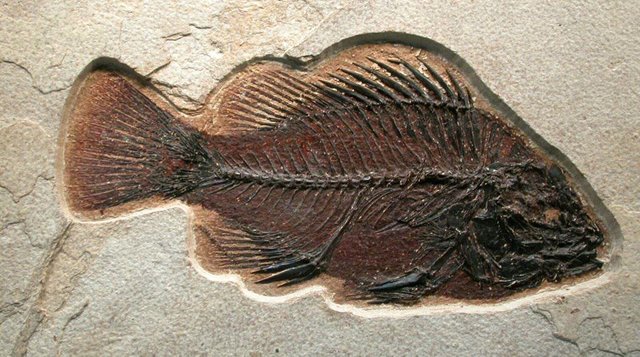
Like the Pesciara di Monte Bolca, the Green River Formation is dated to the Eocene Epoch, roughly around 50 Mya. Millions of fish fossils have been recovered since the identification of the formation in the 19th century. It is located in Colorado, Utah and Wyoming, so I cannot explain why Velikovsky (or Price?) refers to it as “the Green River bed of Arizona”. There is a Verde River in Arizona, but no Green River.
Velikovsky’s “black limestone of Ohio and Michigan” actually refers to the Black River Group, a formation of Ordovician (485-445 Mya) rocks first identified in the valley of the Black River in upper New York. In the late 19th century, these rocks were a so rich a source of petroleum that Ohio was for a time the worlds largest oil producer.
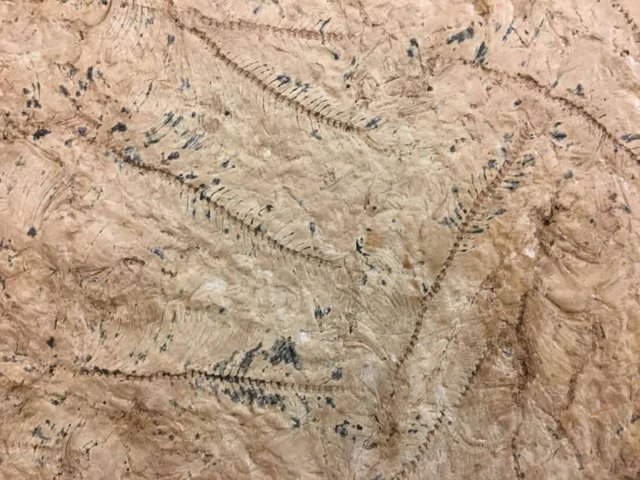
Diatoms are a group of unicellular algae. The diatom beds of Lompoc in California are renowned for their fossil fishes, many of which appear to have perished in mass fish-kills. For example:
From the natural history view, this stratum is the most remarkable feature of the deposit. At about 950 feet from the bottom, at a certain horizon everywhere the same, is a layer of an extinct herring, described by us in a previous paper as Xyne grex. Individuals lie on the bottom wherever this layer has been exposed. They are all of about the same size, about six inches long, all adult and nowhere mixed with any other fish. Apparently the species swarmed in the bay for spawning purposes, and the entire mass was heated, suffocated, or otherwise killed in an instant and with no evidence of agony or distortion. (Jordan & Gilbert 7)
Charles Ginenthal and Stephen Jay Gould
The palaeontologist Stephen Jay Gould has criticized this section of Earth in Upheaval, pointing out that the millions of fish fossils discussed by Velikovsky were distributed throughout strata that had been laid down over millions of years. They were not the victims of a single cataclysmic event:

Velikovsky discusses the fossil fishes of the Old Red Sandstone ... He cites evidence of violent death—contortion of the body, lack of predation, even signs of “surprise and terror” engraved forever on fossil faces. He infers that some sudden catastrophe must have extirpated all these fishes; yet, however unpleasant the death of any individual, these fishes are distributed through hundreds of feet of sediment that record several million years of deposition! (Gould 155-156)
To this the Velikovskian Charles Ginenthal retorted;
What Gould never explains is how millimeter by millimeter of sediment deposition failed to keep fish from all over the world from rotting or being eaten by bacteria or scavengers before being completely buried and protected from these destructive processes. (Ginenthal 452-453)
Elsewhere, Ginenthal cites the work of French geologist Guy Berthault, who demonstrated in the 1980s that laminated strata indistinguishable from those of the Earth’s crustal sediments can be created by a single deposition event (Ginenthal 426 ff). Mainstream academia considers Berthault little better than a creationist, though he has never claimed to be such.
Late Devonian Extinction
The very first passage that Velikovsky cites from Hugh Miller’s The Old Red Sandstone was highly prescient for its day:
[The Old Red Sandstone] presents us, too, with a wonderful record of violent death falling at once, not on a few individuals, but on whole tribes. (Miller 1865:48)
Palaeontologists now believe that at least two major extinction-level events occurred during the latter stages of the Devonian: the Kellwasser Event (End-Frasnian), which opened the final phase of the Devonian around 370 Mya : and the Hangenberg Event (End-Famennian), which closed the Devonian around 360 Mya. As many as eight other mass extinctions may also have occurred during the late Devonian, but the Kellwasser and Hangenberg Events were the most significant. Each, in fact, was probably more severe than the late Cretaceous event that wiped out the dinosaurs. It is currently estimated that as many as 75% of all species were destroyed during the Late Devonian extinctions.
The causes of the Kellwasser and Hangenberg Events are still being debated. Asteroidal impacts have been proposed and possible impact craters identified, but the hypothesis is disputed. Naturally, Uniformitarians would like to spread a mass extinction over a period of several million years, while Catastrophists would prefer to find a single cataclysmic explanation. The problem with the former is that seems to contradict the very basis of evolution. If conditions on Earth are such that a mass extinction begins but proceeds so slowly that it takes millions of years to conclude, why do the animals and plants not evolve to fit these new conditions? I see no way round this dilemma. I suspect that every mass extinction is caused by an asteroidal impact—but this is a subject I have not yet looked into, so I will not press the point here. I will just note that Ginenthal has suggested that the Kellwasser and Hangenberg Events were in fact one and the same event—a single catastrophe that wiped out 75% of all species in a matter of days or weeks—and that the ten million years or so that supposedly separate them are fictitious.
Epilogue
It is ironic that Velikovsky felt compelled to edit Hugh Miller’s text in order to put a suitably cataclysmic complexion on his evidence, little reckoning that the Old Red Sandstone preserved the record of two (or perhaps one) of the most cataclysmic events that have ever befallen this planet.
References
- William Buckland, Geology and Mineralogy Considered with Reference to Natural Theology, Treatise 6 of The Bridgewater Treatises, Volume 1, William Pickering, London (1836)
- Edward Drinker Cope, A Contribution to the Knowledge of the Ichthyological Fauna of the Green River Shales, in F V Hayden (editor), Bulletin of the United States Geological and Geographical Survey of the Territories, Volume 3, (1877)
- Charles Ginenthal, Darwin and Velikovsky: Cataclysmic Metamorphic Evolution: A Materialist Theory of Evolution Based on New Principles and Evidence, Ivy Press Books, Forest Hills NY (2016)
- Stephen Jay Gould, Ever Since Darwin: Reflections in Natural History, W W Norton & Company, New York (1977)
- David Starr Jordan, James Zaccheus Gilbert, Fossil Fishes of Diatom Beds of Lompoc, California, Stanford University Press, Stanford CA (1920)
- John Muirhead Macfarlane, Fishes the Source of Petroleum, The Macmillan Company, New York (1923)
- William Mackay Mackenzie, Hugh Miller: A Critical Study, Hodder and Stoughton, London (1905)
- George McCready Price, Evolutionary Geology and New Catastrophism, Pacific Press Publishing Association, Oakland CA (1926)
- Hugh Miller, The Old Red Sandstone, or, New Walks in an Old Field, John Johnstone, Edinburgh (1841)
- Hugh Miller, Foot-Prints of the Creator, or, The Asterolepis of Stromness, Johnstone and Hunter, London (1849)
- Hugh Miller, The Testimony of the Rocks, Thomas Constable & Co, Edinburgh (1857)
Image Credits
- Devonian Fish Fossil from Scotland (Pterichtyodes milleri): © Copyright Summers Place Auctions, Fair Use
- Old Red Sandstone at Meikle Poo Craig, Scotland: Wikimedia Commons, © Lisa Jarvis, Creative Commons License
- Hugh Miller: Wikimedia Commons, Bell (engraver), after James Good Tunny (photographer), Creative Commons License
- Drawings of Fish Fossils from Miller’s The Old Red Sandstone: Hugh Miller, The Old Red Sandstone, Wikimedia Commons, Public Domain
- Miller’s Diagram of the Geology of the Old Red Sandstone: Hugh Miller, The Old Red Sandstone, Wikimedia Commons, Public Domain
- George McCready Price: Creative Commons License
- John Muirhead Macfarlane: Elsa Koenig Nitzsche (painter), Copyright © 2018, University of Pennsylvania, Fair Use
- Monte Bolca, Province of Verona: © 2018 Mundo Prehistórico, Fair Use
- Green River Fish Fossil (Priscacara serrata): © L Grande, Paleontology of the Green River Formation, with a Review of the Fish Fauna, Edition 2, The Geological Survey of Wyoming Bulletin, Volume 63 (1984), Fair Use
- Diatomite Fossils (Lompoc CA): © 2018 Diatoms of North America, Fair Use
- Stephen Jay Gould: © Copyright 2004 Columbia University, Fair Use

U always post unique article. Thts y i like you
excellent post good article wonderful natural photography i like your post thanls for share dear @harlotscurse
Very good old post writer you are. Great. Salute brother. Love you.
Perfect a very complete and interesting post science and nature fantastic board you see it was a great Hugh Miller good job friend great post